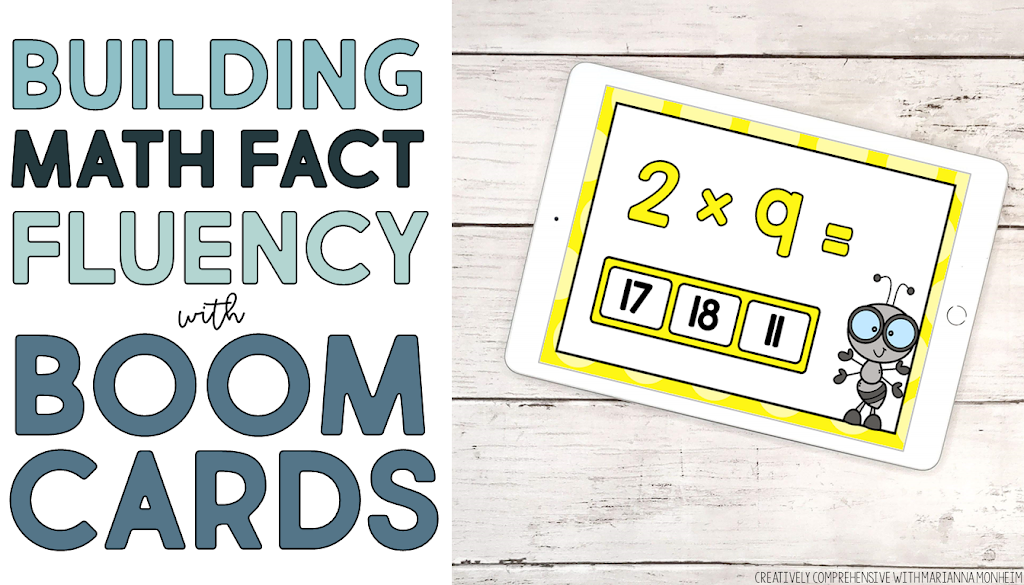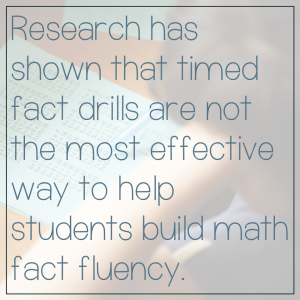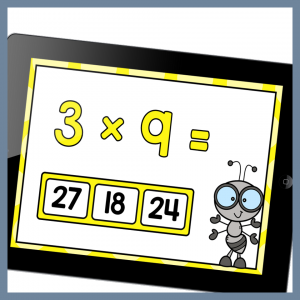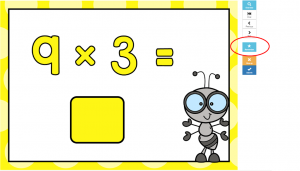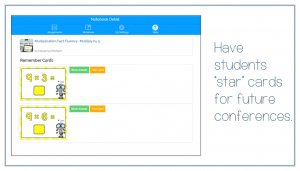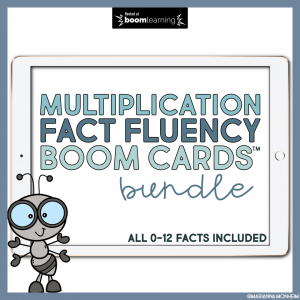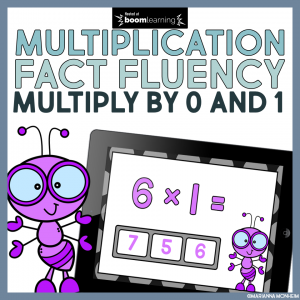Boom Cards are digital, interactive self-checking task cards that are highly engaging- perfect for building math fact fluency! Students are drawn to Boom Cards because of the bright graphics and interactive gameplay, but there are additional reasons for teachers to get excited about Boom! In this post, I will share why the Boom Learning platform lends itself well to helping children master their math facts.
(Note: Although Boom is free to use, there are some features mentioned that will require a subscription to the Boom website. I am not an affiliate of Boom and will receive no compensation should you choose to sign up after reading.)
The Importance of Fact Fluency
Although there may be differing opinions about HOW to build fact fluency, most everyone agrees on WHY students need to be able to recall math facts from memory. For students to be successful with more complex math tasks, they must have a solid foundation of basic math facts to work with. Why? Think of the brain like a gas tank. If a student is working on a complex mathematical task (for example, a word problem), we don’t want them to use up all of their gas on computation. By the time they get to the hard work of solving the problem, they will be running on fumes! Students who can recall math facts from memory will be able to devote more brainpower to the problem-solving process.
Effective Teaching of Math Facts
Research has shown that timed fact drills are not the most effective way to help students build math fact fluency. Many students report high levels of anxiety while taking such assessments, and the resulting data may not effectively showcase their true abilities.
According to the National Council of Teachers of Mathematics and the Common Core Standards, real fact fluency involves accuracy, flexibility, efficiency, and appropriate strategy use while recalling facts. You can address all four of these characteristics by thoughtfully and strategically incorporating Boom Learning into your math instruction.
Using Boom Learning During Your Math Instruction
Let’s quickly talk about how Boom Learning works. On the Boom Learning platform, you will search for “decks” to assign your students. There are many free decks, but you can also purchase points from Boom to buy decks.
If you choose not to pay for a subscription to the site (separate from purchasing points), you will be able to assign the decks to your class using a FastPlay link. Still, You won’t, however, be able to differentiate and assign different decks to different students. You also won’t be able to view the reports or alter the decks in any way. With a subscription, you will be able to see a variety of data about how your students interact with each card, as well as hide cards or change the number of cards played in a deck.
Now that we understand the basics let’s talk about how Boom Cards can be a game-changer when it comes to building math fact fluency! First of all, let’s take what we already know about best practices and how to incorporate that into Boom. Students can best build fact fluency by participating in a brief, daily routine practice of a targeted group of facts. They should work on those facts until they can recall them quickly from memory, then move on to a new group of facts. It is far better for students to work on building fact fluency for a small amount of time each day rather than extended periods on an inconsistent basis.
How can Boom help you with that? First of all, most Boom decks are, for lack of a better term, “short and sweet.” They are tailored to hit one specific area and meant to be completed quickly (for example, my Multiplication Fact Fluency Decks all focus on one set of facts and can be completed in under five minutes). You can easily add Boom cards to your math instruction block, whether you choose to have your students work on Boom as a bell ringer, after you complete your whole group instruction, or even as a homework assignment or exit slip. As students progress through their fact study, you can quickly assign new decks.
Students also benefit from learning facts in a low-risk environment. In addition to being highly interactive and engaging, Boom Cards are 1:1, so students are only competing against themselves. Boom cards allow students to demonstrate their knowledge of math facts without the anxiety that comes along with timed math drills.
Now, let’s dig deeper to see how using Boom Cards supports the four characteristics of effective fact fluency practice.
Accuracy
Boom Cards are self-checking, so your students will receive immediate feedback as they work through the deck. When students answer a question incorrectly, they will hear a “whoops” sound and be able to try again. As a teacher, you will be able to see how many cards the student answered correctly and use that information to determine when the student is ready to learn a new set of facts. If you choose to have students play each deck multiple times, you will be able to see if they are moving through the cards more quickly each time.
Efficiency
It’s not enough for students to just know the answer to a math fact, we want them to recall it quickly and easily. The reports in Boom will provide you with valuable information to show you how efficiently students are moving through the deck. Each time a student plays the deck, you can generate a report that shows how long it took for them to input their answer. Also, if they picked the wrong answer, you can click on each individual card in the deck to see which answer they selected.
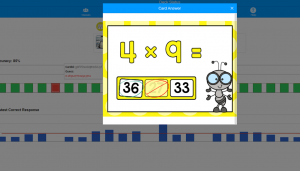 |
| You can click on each individual card in the report to see what answers the student selected. |
Flexibility
By using a deck focused on one set of facts, students will be able to really focus on each fact and think about the best way to determine the answer. If your whole group instruction focused on a specific strategy (for example, skip counting), you might choose to have students focus on that strategy as they go through a deck and think about if it was helpful to them in determining the answers.
Appropriate Strategy Use
A great feature Boom has on the student end is the ability to “star” cards. By having your students get into the practice of starring the cards they get wrong, you can set up individual conferences specifically tailored to their areas of weakness. For example, you may notice that when working on zero and one fact fluency that the student answered all “x1” facts with “1”. By looking at the starred cards with the student, you would be able to explain that the x0 and x1 facts do not use the same rule to determine the answer.
You could also have students journal about the cards they starred, explaining in their own words why their initial answer was wrong and what they did to change their thinking. There are lots of different ways to discuss strategies by using a combination of the starred student cards and your reports!
Other Great Features of Boom Cards
One of my favorite things about Boom Cards is the randomization feature. Each time a student plays a deck, the cards will randomize. Also, cards with multiple-choice options will randomize the choices each time the deck is played. This means there’s no way for students to memorize the deck, so a) your data will be accurate, and b) your students won’t get bored repeating a deck more than once!
Another thing I love about Boom is the flexibility of use. While this blog post was mostly about students using decks independently, Boom Cards can be a great lesson starter! Also, Boom Learning is an excellent choice for the classroom, for distance learning, or for hybrid models. The site is easy to navigate for both teachers and students.
Ready to jump into Boom? Check out my Multiplication Fact Fluency decks! You can purchase decks individually, or save 30% by purchasing the bundle! Don’t forget to check out the free preview on Boom to see the cards in action!
Click here to see the bundle on TpT.
Need to see more? The 0 and 1 fact deck is FREE! This will give you a good idea of how each deck is formatted. Click here to see the FREE 0 and 1 Multiplication Fact Deck.
Have your students already mastered the facts, and you need them to review? Check out the Multiplication Facts Review Deck!
How do you think you might incorporate Boom Cards into your classroom?


